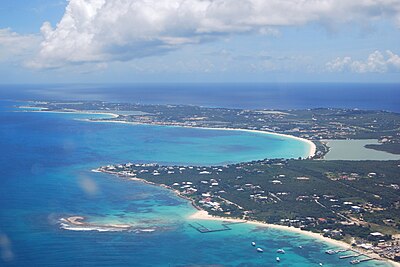Thursday, December 29, 2011
Saturday, December 24, 2011
Anguilla...
Just arrived at Anguilla, island above St Maarten..
See what they have for dinner on the 24th of dec..
Cheers and have a nice time/days..
Anguilla is a British overseas territory and overseas territory of the European Union in the Caribbean. It is one of the most northerly of the Leeward Islands in the Lesser Antilles, lying east of Puerto Rico and the Virgin Islands and directly north of Saint Martin. The territory consists of the main island of Anguilla itself, approximately 26 km (16 mi) long by 5 km (3.1 mi) wide at its widest point, together with a number of much smaller islands and cays with no permanent population. The island's capital is The Valley. The total land area of the territory is 91 km2 (35 sq mi), with a population of approximately 13,500 (2006 estimate).
Anguilla has become a popular tax haven, having no capital gains, estate, profit or other forms of direct taxation on either individuals or corporations.
History
Main article: History of Anguilla
Anguilla was first settled by Amerindian tribes who migrated from South America.
The earliest Amerindian artifacts found on Anguilla have been dated to
around 1300 BC, and remains of settlements date from 600 AD.[5] The date of European discovery is uncertain: some sources claim that Columbus sighted the island in 1493, while others state that the island was first discovered by the French in 1564 or 1565.[6] The name Anguilla derives from the word for "eel" in any of various Romance languages (modern Spanish: anguila; French: anguille; Italian: anguilla; Portuguese: enguia), probably chosen because of the island's eel-like shape.Anguilla was first colonised by English settlers from Saint Kitts, beginning in 1650.[7] The French temporarily took over the island in 1666 but under the Treaty of Breda it was returned to English control. In this early colonial period Anguilla sometimes served as a place of refuge. A Major John Scott who visited in September of 1667 wrote of leaving the island "in good condition" and noted that in July 1668 "200 or 300 people fled thither in time of war."[8] Other early arrivals included Europeans from Antigua and Barbados. It is likely that some of these early Europeans brought enslaved Africans with them. Historians confirm that African slaves lived in the region in the early 17th century. For example, Africans from Senegal lived in St. Christopher (today St. Kitts) in 1626. By 1672 a slave depot existed on the island of Nevis, serving the Leeward Islands. While the time of African arrival in Anguilla is difficult to place precisely, archival evidence indicates a substantial African presence (at least 100) on the island by 1683.
While traditional histories of the region assume that "the English" were the first settlers of Anguilla under British rule, recent scholarship focused on Anguilla offers a more nuanced view. It emphasizes the significance of early sociocultural diversity. This research suggests that St. Christopher,[9] Barbados, Nevis and Antigua are all significant points of origin. Regarding African origins, West Africa as well as Central Africa are both posited as the ancestral homelands of some of Anguilla's early African population.[10]
During the early colonial period, Anguilla was administered by the British through Antigua, but in 1824 it was placed under the administrative control of nearby Saint Kitts. In 1967, Britain granted Saint Kitts and Nevis full internal autonomy, and Anguilla was also incorporated into the new unified dependency, named Saint Christopher-Nevis-Anguilla, against the wishes of many Anguillians. This led to two rebellions in 1967 and 1969 (Anguillian Revolution), headed by Ronald Webster, and a brief period as a self-declared independent republic. British authority was fully restored in July, 1971. In 1980 Anguilla was finally allowed to secede from Saint Kitts and Nevis and become a separate British colony (now termed a British overseas territory).
Politics
Main article: Politics of Anguilla
See also: Law of Anguilla
Anguilla is an internally self-governing overseas territory of the United Kingdom. Its politics take place in a framework of a parliamentary representative democratic dependency, whereby the Chief Minister is the head of government, and of a pluriform multi-party system.The United Nations Committee on Decolonization includes Anguilla on the United Nations list of Non-Self-Governing Territories. The territory's constitution is Anguilla Constitutional Order 1 April 1982 (amended 1990). Executive power is exercised by the government. Legislative power is vested in both the government and the House of Assembly. The Judiciary is independent of the executive and the legislature.
Military
As a dependency of the UK, the UK is responsible for its military defence, although there are no active garrison or armed forces present.Geography
Main article: Geography of Anguilla
Anguilla is noted for its spectacular and ecologically important coral reefs and beaches. Apart from the main island of Anguilla itself, the territory includes a number of other smaller islands and cays, mostly tiny and uninhabited. Some of these are:
- Anguillita
- Dog Island
- Prickly Pear Cays
- Sandy Island
- Scrub Island
- Scilly Cay
- Seal Island
- Sombrero, also known as Hat Island
Monday, December 19, 2011
Sunday, December 18, 2011
Saturday, December 10, 2011
St Maarten...
We arirved at Simpson Bay friday/sat night at 0300 after losts of wind and nice trip,
everything very well no damages exept one shackle and fishingline line in windgenerator.
Friday, December 2, 2011
Subscribe to:
Posts (Atom)




